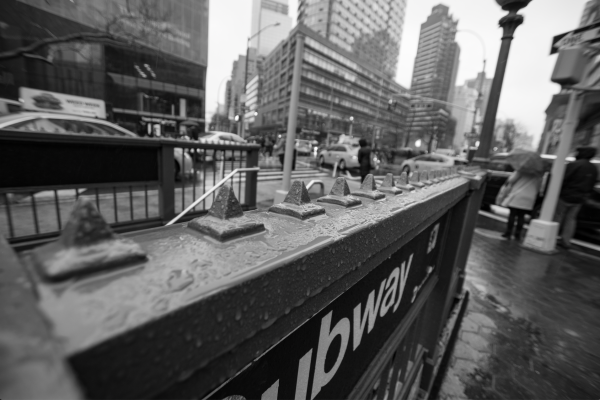Hostile Architecture in New York City
Spikes, dividers and more alienate several of New York City’s most marginalized groups. (ANDREW BEECHER/THE OBSERVER)
April 4, 2018
Having been born and raised in New York City, I have seen a myriad of changes in the city’s infrastructure. It seems as though every time I ride the subway, there is another foundational change that has materialized. One issue that has piqued my interest over the past 19 years is the progression in change of the city’s MTA system, particularly within its subway stations.
Last year, the MTA implemented its “Enhanced Station Initiative” which renovated stations along the R-line. As someone who rides the R-line regularly, I was optimistic at first about the planned changes. I had hoped that the MTA would make lasting improvements that would benefit everyone’s overall commute, and that maybe, with the temporary shutdown of the stations, more elevators would be installed. However, this was not the case. Instead, the newly-renovated stations merely offered surface level beneficences through the construction of brightly colored entrance canopies, countdown clocks and USB charging ports. One of the most drastic changes was the introduction of “leaning bars”—angled wooden blocks stationed across the subway walls. These are what disturbed me most about this “enhancement” plan, as they have taken the place of some benches in the newly-renovated subway stations. Although the leaning bars are aesthetically appealing with their sleek outward appearance, they were purposefully designed with discomfort in mind.
Seeing these costly subway renovations reminded me of the other times I have been around the city, excited to enjoy various public spaces, only to find them uncomfortable, to say the least. Unfortunately, these updates to the commute only serve the interests of those who use the MTA as a transitory place, stopping during a vacation with their families to stand in awe at the city. Yet, they place the habitual rider, linked to this catacomb by birthright and wage-slavery, disinvested and tired, to be shepherded like animals on their routes between sites of productive and reproductive labor.
Upon further examination, it becomes clear that most, if not all, the benches within urbanized areas—specifically New York City—have been created with the intent to create uncomfortableness; benches were created for patrons to sit, but not get too comfortable. The benches situated throughout New York City have rigidly structured armrests dividing the benches, short backs and hard seats. This is to prevent patrons from sleeping on the benches. This is what is referred to as “hostile architecture”: the moderation of actions by limiting the ways in which infrastructure is used.
Indeed, hostile architecture can certainly prevent loitering and the misuse of public objects, but these public designs represent something more nefarious for New York City’s homeless population. It is designs like these that are seemingly useful, but at others’ expense.
By this same token, there are several examples of hostile architecture that specifically victimize the homeless throughout New York City. Some examples include the infamous “anti-homeless” spikes, barbed wires and sidewalk barricades. In the case of the MTA’s “Enhanced Station Initiative,” removing benches in order to implement sleek leaning bars further strips away the already limited potential places to sleep for those with nowhere else to go.
Although homelessness is decreasing overall within the United States, the homeless population in New York City is increasing. Emergency homeless shelters are not always viable options for New York City’s homeless. Most homeless shelters do not have the funding to properly address the mental well-being of each individual resident, which only further contributes to the overwhelmingly hostile environment of homeless shelters. Due to the lack of proper supervision and funding, violence and robbery run rampant throughout New York City’s homeless shelters. This results in people being forced to sleep on benches situated throughout the five boroughs.
As a consequence of hostile architecture, social divisions, therefore, become salient with regards to public infrastructure, making the commute harder for working parents—especially single mothers who have to take their kids with them. As hostile architecture becomes more prominent in New York City, it conversely creates public spaces alienating to the city’s disabled, homeless, working-class and elderly populations. Designs such as the leaning bar implicitly beg the question: if public space is not meant to be shared with the homeless, where should New York City’s homeless go? After all, most would rather risk dying in the streets than be brutalized and abused in underfunded homeless shelters.
The MTA has announced its desire to potentially expand this “Enhanced Station Initiative” into other parts of Brooklyn. While it is discouraging to see public space being taken away from underprivileged New Yorkers, I choose to remain hopeful, as speaking out against these injustices will help bring awareness and hopefully with it, change. Hostile architecture is a physical manifestation of New York City’s policy towards all who live here. There are over 63,000 homeless people living in New York; it’s high time they’re made to feel at home.









